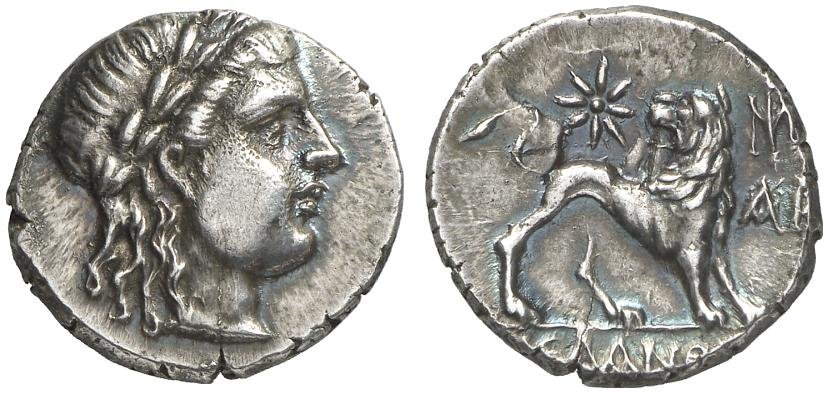S 346 - Miletus, silver, drachma, 150-130 BC
From SILVER
150 BCE - 130 BCE Silver 1,768 kg
Description
| ObverseInscription or printing placed on the obverse.: | Head of Apollo left or right, wearing laurel wreath. |
| ReverseInscription or printing placed on the reverse.: | monogram of the city (Greek).Lion left or right, head reverted, above, a star. In the field, name and monogram. |
Mint and issuing power
| MintIdentifies the place of manufacture or issue of a numismatic object.: | Miletus | Ancient regionAncient region.: | Ionia | Modern countryModern country: Turkey | AuthorityIdentifies the issuing power. The authority can be "pretended" when the name or the portrait of X is on the coin but he/she was not the issuing power. It can also be "uncertain" when there is no mention of X on the coin but he/she was the issuing power according to the historical sources: |
Chronology
| FromIdentifies the initial date in a range assigned in a numismatic context. | 150 BCE | toIdentifies the final date in a range assigned in a numismatic context.. | 130 BCE | PeriodTime period of the numismatic object.: Hellenistic 323-30 BC |
Physical description
| MetalThe physical material (usually metal) from which an object is made.: | Silver |
Median weightMedian of the weights of numismatic objects (in grams). in grams | 4.90 | DenominationTerm indicating the value of a numismatic object. Examples: tetradrachm, chalkous, denarius.: | drachma |
StandardStandard.: |
Image

S_346_-_Miletus,_silver,_drachma,_150-130_BC.jpg [1]
References
| Die study referencePublication of the study: | Kinns 19981Kinns 1998, p. 175-195, pl. 38-46 (catalog p. 183-195, drachmas of the phase III). | ||
| Coin series referenceReference to coin series study: | |||
Obverse dies distribution
| FrequencyFrequency of specimen in distribution. ᵖ | Number of obversesNumber of obverse dies. ᵖ (o) | % (o) | Number of coinsNumber of coins. (n) | % (n) | Die nameName(s) of the die(s). |
| 1 | 2 | 12.5 | 2 | 2.7 | O52, O75A |
| 2 | 4 | 25 | 8 | 10.81 | O55, O56, O63, O64 |
| 3 | 3 | 18.75 | 9 | 12.16 | O56A, O67, O52A |
| 4 | 1 | 6.25 | 4 | 5.41 | O65 |
| 5 | 3 | 18.75 | 15 | 20.27 | O72, O73, O75 |
| 7 | 1 | 6.25 | 7 | 9.46 | O68 |
| 10 | 1 | 6.25 | 10 | 13.51 | O53 |
| 19 | 1 | 6.25 | 19 | 25.68 | O69 |
| Total | 16 of 16 | 100 | 74 of 74 | 100 |
Reverse dies distribution
no distribution is available
Quantification
| Number of obversesNumber of obverse dies. ᵖ (o) | 16 | Number of singletons (o1)The number of singleton coins. ᵖ | 2 |
| Number of reverse diesNumber of reverse dies. (r) | 34 | Number of coinsNumber of coins. (n) | 74 |
| Coins per obverse dieNumber of coins per obverse die. (n/o) | 4.63 | Coins per reverse dieNumber of coins per reverse die. (n/r) | 2.18 |
| Reverse per obverse ratioRatio of obverse dies divided by reverse dies. (r/o) | 2.13 | Percentage of singletons (o1)number of coins (n) divided by the number of singletons (o1) ᵖ | 12.5 % |
| Original number of dies (O) (Carter 1983 formula)The estimation of the number of coins according to Carter 1983 ᵖ | 18.04 | Coins struck if 20,000 as average productivity per dieCoins made if the average productivity for obverses (according to Carter) is 20,000. ᵖ | 360,800 |
| Original number of dies (O) (Esty 2011 formula)The estimation of the number of coins according to the singleton formula in Esty 2011 ᵖ (O) | 20.41 | Survival rate if 20,000 as average productivity per dieSurvival rate if average productivity is 20,000. ᵖ | 0.00021 |
| Coverage (o = % of O) (Esty 1984 formula)Esty 1984 - coverage (% of O) ᵖ (o = % of O) | 97.3% | Die productivity if survival rate 1/2,000Average productivity if survival rate is 1/2,000. ᵖ | 8,203.99 |
| Weight of silver (in kg) if 20,000 coins per die (O = Carter formula)Carter 1983 * Median weight * 20000 (*10 if gold or electrum) ᵖ | 1,768 kg <br /> 1,768 kg | Die productivity if survival rate 1/5,000Average productivity if survival rate is 1/5,000. ᵖ | 20,509.98 |
Remarks
References
- ^ Kinns, Philip (1998), "CH 8, 474: Milesian Silver Coinage in the Second Century BC", in Richard Ashton and Silvia Hurter (eds.), Studies in Greek Numismatics in Memory of Martin Jessop Price, London, p. 175-195, pl. 38-46.